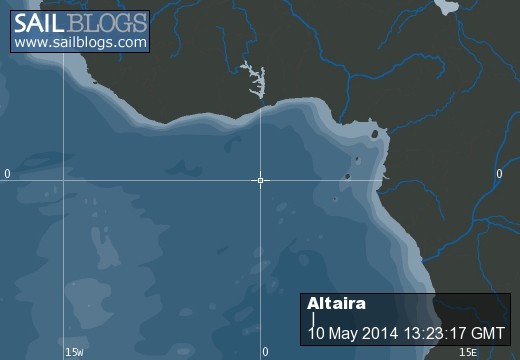Profile

Who: Kimball Corson. Text and Photos not disclaimed or that are obviously not mine are copyright (c) Kimball Corson 2004-2016
Port: Lake Pleasant, AZ
Altaira Wandering the Oceans
Favorites
- 7 Seas Cruising Association
- American Sailing Association
- Buoyweather Service
- CDC Traveler's Heath Advisories
- Cruiser Log venue
- Cruisers Forum
- Cruising Club of America
- Cruising Resources
- Cruising World Magazine
- Earthrace World Record
- Economic and Financial Indicators
- Economist Magazine
- Equipmment and Boat Reviews
- Float Plan Form
- Greenpeace Int'l
- Grib File Access
- Heavy Weather Sailing
- IMS Certificates
- Inland Travel: Expedia
- Intrade Prediction Markets
- Latitude 38
- London Financial Times
- Marine Books and Charts
- Marine Radios
- Nature Conservancy for Oceans
- New York Times
- NOAA Hurricane Analysis
- NOAA Weather Forecasts
- Noonsite, World Cruisng Info
- Ocean Cruising Club
- Overseas Mail Forwarding Services
- Practical Sailor Magazine
- RGE Economic Monitor
- Sail Gear Source I
- Sail Gear Source II
- Sail Gear Source III
- Sail Gear Source IV
- Sailboat Selection for Offshore Use
- Sailboats for Sale
- Sailing Items Sources Links
- SailMail (Marine Radio)
- Sailnet Sailing Information
- Seeking Alpha
- Tide & Current Program
- Tide Prediction Programs
- Tides & Currents
- TruthDig in the News
- U.S. Sailing Association
- Univ of Chicago Law Faculty Blog
- US State Dept Travel Advisories
- Voyage Planning (with pilot charts)
- Wall Street Journal
- Washington Post
- Weather.com
- Weather: MagicSeaweed
- Weather: Wetsand
- WinLink (Ham Radio)
- World Clock + Time Zones
09 April 2018 | Pago Pago, American Samoa
10 March 2018 | Pago Pago, American Samoa
10 March 2018 | Pago Pago, American Samoa
10 March 2018 | Pago Pago, American Samoa
22 August 2017 | Pago Pago, American Samoa
22 August 2017 | Pago Pago, American Samoa
22 August 2017 | Pago Pago, American Samoa
22 August 2017 | Pago Pago, American Samoa
22 August 2017 | Pago Pago, American Samoa
22 August 2017 | Pago Pago, American Samoa
22 August 2017 | Pago Pago, American Samoa
22 August 2017 | Pago Pago, American Samoa
22 August 2017 | Pago Pago, American Samoa
22 August 2017 | Pago Pago, American Samoa
22 August 2017 | Pago Pago, American Samoa
22 August 2017 | Pago Pago, American Samoa
22 August 2017 | Pago Pago, American Samoa
22 August 2017 | Pago Pago, American Samoa
22 August 2017 | Pago Pago, American Samoa
09 August 2017 | Pago Pago, American Samoa
Note on Debt and the Fed
11 May 2016 | Pago Pago, American Samoa
Kimball Corson

In the view of one tabulator, global debt increased by $57 trillion in the seven years ending 2014. At 9.3% growth, government debt swelled to $58 trillion from a starting point of $33 trillion. Corporations saw their debt levels rise by 5.9% to $56 trillion from $38 trillion. Household debt saw no comparable grow because there has actually been some deleveraging in that quarter. The IMF, a fount of neo-classical economics, is sounding a warning on these debt levels, claiming they are too high and threatening, except of course for household debt. So what are we to make of this debt? We need to consider first what debt is and how it is used.
Debt arises when one firm, person or government wants to borrow cash that someone else has and is willing to lend. Making interest payment (servicing) and timely payback are the issues. Others, less considered, are how is the borrowed money used, for investment which generates a cash return, or for consumption, which does not. Next, who is the borrower, a firm or household, each of which has a budget restraint within which serving and loan repayment need to be made, or a government with its own sovereign fiat currency which has no budget restraint and can rollover debt and print more money within allowable bounds. (EU countries, it should be noted share a common currency and each lack a sovereign fiat currency of their own so each must live within a budget restraint and must consider where to get the money to pay interest and loans back or face a mess like Greece has.)
Two extremes arise generally arise: money borrowed to invest which generates more money thereby making servicing and payback easier and money borrowed for foolish consumption which spends now with no realistic notion or thought given to interest and payback (e.g., Greece). From here, it is but an easy step to realize how low interest rates and easy money for loans, trap the unwary and induced excessive borrowing. That due diligence is normally practiced by lenders makes it clear that lenders too are at fault when the borrower defaults and they have not done that due diligence properly, a point often raised by bankruptcy attorneys for debtors.
In light of this analysis, it can be seen that our Fed has screwed up royally and put the nation at risk with excessive corporate debt in an era of declining corporate profits. The precursor of all major depressions and major recessions is a financial crash where there are loan defaults of many firms and/or households involving large total sums of money. The Fed does not understand any of this.
Nor does it understand the charge that it has enriched the wealthy and seriously worsened the distribution of income 1) by using QE and open market operations to purchase the dicey financial assets of the wealthy and push much extra cash into the economy (a form of monetarism), and 2) by inducing lower interest rates and consequently lower discount rates to increase the valuations of financial assets (read stocks and bonds) held by the rich and wealthy.
The Fed genuinely does not know what the hell it has been doing in its naive effort to "increase investment." The problem is much worse than pushing a string. Using interest rates to regulate real economic activity is proving to be as big a failure as monetarists at the Fed were using monetary aggregates to try to do the same thing. The Fed simply has not realized it yet.
As long as nations can service and repay (and rollover) their public debt, that debt will not be a serious problem. Servicing and payback can become problems even for nations with sovereign fiat currencies where they are ravaged by high inflation, their productive capability or tax system collapses, their main export markets collapse and for a few other reasons, most all involving bad management and misjudgments.
Private debt is the issue and the Fed is too much asleep at the wheel and does not realize what it has been doing.
Debt arises when one firm, person or government wants to borrow cash that someone else has and is willing to lend. Making interest payment (servicing) and timely payback are the issues. Others, less considered, are how is the borrowed money used, for investment which generates a cash return, or for consumption, which does not. Next, who is the borrower, a firm or household, each of which has a budget restraint within which serving and loan repayment need to be made, or a government with its own sovereign fiat currency which has no budget restraint and can rollover debt and print more money within allowable bounds. (EU countries, it should be noted share a common currency and each lack a sovereign fiat currency of their own so each must live within a budget restraint and must consider where to get the money to pay interest and loans back or face a mess like Greece has.)
Two extremes arise generally arise: money borrowed to invest which generates more money thereby making servicing and payback easier and money borrowed for foolish consumption which spends now with no realistic notion or thought given to interest and payback (e.g., Greece). From here, it is but an easy step to realize how low interest rates and easy money for loans, trap the unwary and induced excessive borrowing. That due diligence is normally practiced by lenders makes it clear that lenders too are at fault when the borrower defaults and they have not done that due diligence properly, a point often raised by bankruptcy attorneys for debtors.
In light of this analysis, it can be seen that our Fed has screwed up royally and put the nation at risk with excessive corporate debt in an era of declining corporate profits. The precursor of all major depressions and major recessions is a financial crash where there are loan defaults of many firms and/or households involving large total sums of money. The Fed does not understand any of this.
Nor does it understand the charge that it has enriched the wealthy and seriously worsened the distribution of income 1) by using QE and open market operations to purchase the dicey financial assets of the wealthy and push much extra cash into the economy (a form of monetarism), and 2) by inducing lower interest rates and consequently lower discount rates to increase the valuations of financial assets (read stocks and bonds) held by the rich and wealthy.
The Fed genuinely does not know what the hell it has been doing in its naive effort to "increase investment." The problem is much worse than pushing a string. Using interest rates to regulate real economic activity is proving to be as big a failure as monetarists at the Fed were using monetary aggregates to try to do the same thing. The Fed simply has not realized it yet.
As long as nations can service and repay (and rollover) their public debt, that debt will not be a serious problem. Servicing and payback can become problems even for nations with sovereign fiat currencies where they are ravaged by high inflation, their productive capability or tax system collapses, their main export markets collapse and for a few other reasons, most all involving bad management and misjudgments.
Private debt is the issue and the Fed is too much asleep at the wheel and does not realize what it has been doing.
Comments
| Vessel Name: | Altaira |
| Vessel Make/Model: | A Fair Weather Mariner 39 is a fast (PHRF 132), heavily ballasted (43%), high-aspect (6:1), stiff, comfortable, offshore performance cruiser by Bob Perry that goes to wind well (30 deg w/ good headway) and is also good up and down the Beaufort scale. |
| Hailing Port: | Lake Pleasant, AZ |
| Crew: | Kimball Corson. Text and Photos not disclaimed or that are obviously not mine are copyright (c) Kimball Corson 2004-2016 |
| About: | |
| Extra: |
Altaira's Photos - Main
No items in this gallery.
Profile

Who: Kimball Corson. Text and Photos not disclaimed or that are obviously not mine are copyright (c) Kimball Corson 2004-2016
Port: Lake Pleasant, AZ
Altaira Wandering the Oceans
Favorites
- 7 Seas Cruising Association
- American Sailing Association
- Buoyweather Service
- CDC Traveler's Heath Advisories
- Cruiser Log venue
- Cruisers Forum
- Cruising Club of America
- Cruising Resources
- Cruising World Magazine
- Earthrace World Record
- Economic and Financial Indicators
- Economist Magazine
- Equipmment and Boat Reviews
- Float Plan Form
- Greenpeace Int'l
- Grib File Access
- Heavy Weather Sailing
- IMS Certificates
- Inland Travel: Expedia
- Intrade Prediction Markets
- Latitude 38
- London Financial Times
- Marine Books and Charts
- Marine Radios
- Nature Conservancy for Oceans
- New York Times
- NOAA Hurricane Analysis
- NOAA Weather Forecasts
- Noonsite, World Cruisng Info
- Ocean Cruising Club
- Overseas Mail Forwarding Services
- Practical Sailor Magazine
- RGE Economic Monitor
- Sail Gear Source I
- Sail Gear Source II
- Sail Gear Source III
- Sail Gear Source IV
- Sailboat Selection for Offshore Use
- Sailboats for Sale
- Sailing Items Sources Links
- SailMail (Marine Radio)
- Sailnet Sailing Information
- Seeking Alpha
- Tide & Current Program
- Tide Prediction Programs
- Tides & Currents
- TruthDig in the News
- U.S. Sailing Association
- Univ of Chicago Law Faculty Blog
- US State Dept Travel Advisories
- Voyage Planning (with pilot charts)
- Wall Street Journal
- Washington Post
- Weather.com
- Weather: MagicSeaweed
- Weather: Wetsand
- WinLink (Ham Radio)
- World Clock + Time Zones
